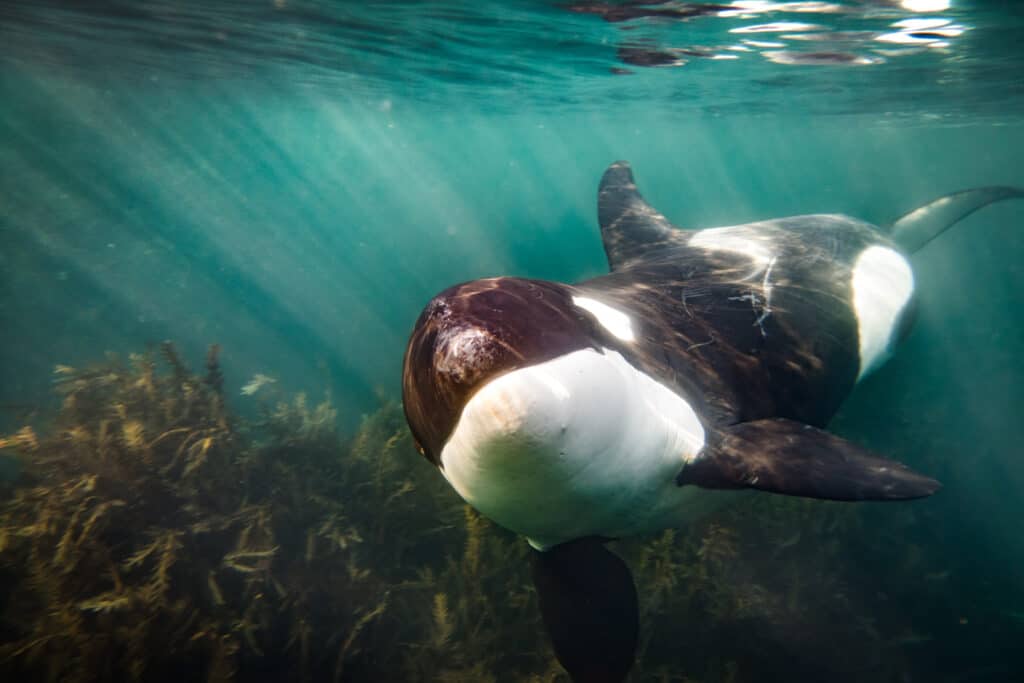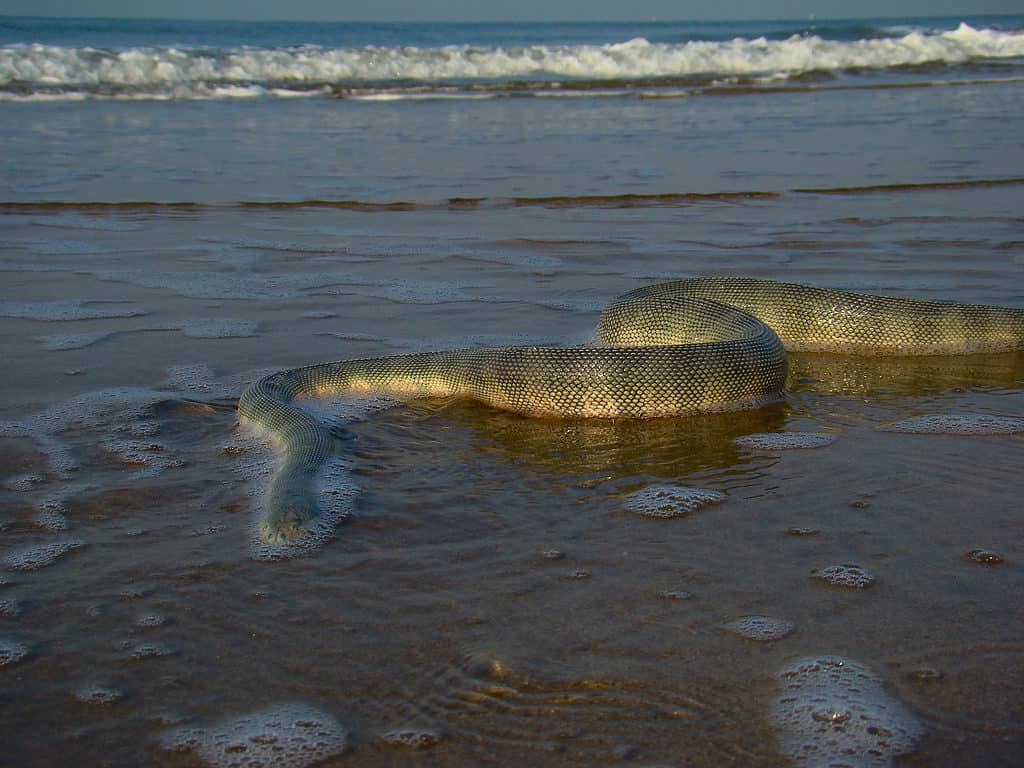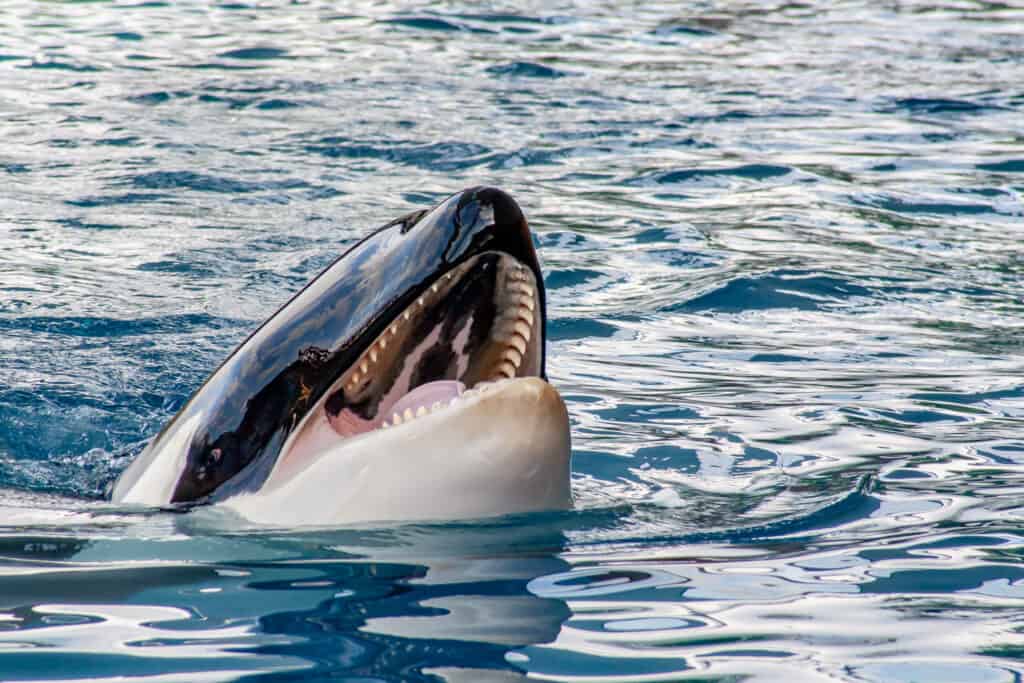The oceans of the world are filled with many deadly creatures. Although killer whales aren’t the vicious killers their name suggests, they are enormous mammals with potent hunting abilities. Meanwhile, some creatures don’t need to be large to be effective hunters.
Dubois’ sea snake has the most powerful venom of any sea snake, and it can easily kill animals larger than itself. What would happen in a battle between a killer whale vs. the most venomous sea snake?
We’re going to break down this hypothetical battle and reveal whether powerful snake venom can level the playing field against a much larger animal.
Comparing a Killer Whale and the Most Venomous Sea Snake
| Killer Whale | Most Venomous Sea Snake | |
|---|---|---|
| Size | Weight: from 6,600 pounds to 15,000 pounds Length: 16 to 26 feet | Length: from 1 to 4.8 feet |
| Speed | – Up to 30 mph | – Less than two mph |
| Defenses | – Large size and tendency to stay in groups will scare off many creatures – The orca’s speed makes it hard to catch – Endurance allows orcas to swim for long distances – Layer of blubber between 3 and 4 inches thick | – Aposematism will frighten predators away – The snake often hides in recessed rocky areas near the sea floor |
| Offensive Capabilities | – The orcas’ intelligence allows them to attack in many ways – Biting power of roughly 19,000 PSI – Possess between 40 and 56 teeth that measure from 2 to 4 inches – Use their tails to slam into prey or knock them off the ice | – Has small teeth measuring 0.07 inches – Has the third most-powerful venom of any snake, with an LD50 of 0.044 mg/kg |
| Predatory Behavior | – Hunts using a variety of techniques – May group hunt and beat prey with their tails – Can use their powerful tails to flip ice floes and capture their prey | – Most likely an ambush predator – Typically attacks fish and eels |
What Are 3 Key Differences Between a Killer Whale and the Most Venomous Sea Snake?
The three biggest differences between a killer whale and Dubois’ sea snake can be found in their morphology, methods of attack, and size. A killer whale is a huge, cylindrical mammal with fins and a large tail, weighing up to 15,000 pounds on average. It uses its tail or teeth to kill prey.
Meanwhile, the most venomous sea snake has a small, elongated body with no limbs, grows about 4.8 feet long at its maximum, and uses venom to disable and kill its prey before consuming it.
These differences have a major influence on the fight and will ultimately determine which one wins. However, we need to look closer at a few other factors before we decide who wins this fight.
What Are the Key Factors in a Fight Between a Killer Whale and the Most Venomous Sea Snake?
We must consider several factors when deciding who wins a fight between a killer whale and the most venomous sea snake. For this fight, we’ve come up with five different factors that will help shape the battle’s outcome. We will explore the five factors in depth, show you which creature has the greater number of advantages over the other, and use the sum of the information to name a winner. Let’s break down this epic battle!
Size

The average killer whale can grow between 16 and 26 feet long while weighing between 6,600 and 15,000 pounds.
©Nick Grobler/Shutterstock.com
The killer whale is much larger than the most venomous sea snake. The average killer whale can grow between 16 and 26 feet long, while weighing between 6,600 and 15,000 pounds. Meanwhile, Dubois’ sea snake only measures between 1 and 4.8 feet on average.
The killer whale has the size advantage, but this enormous mammal can’t win based on size alone.
Speed

The most venomous sea snake can only swim at about two mph.
©IHX/Shutterstock.com
Orcas are very fast swimmers, capable of reaching speeds of 30 mph for a short time. These mammals can maintain a swimming speed of roughly 10 mph for long distances. The most venomous sea snake can only swim at about two mph.
The killer whale has the speed advantage, and that means it could attack first if it had the desire.
Defenses
The most venomous snake relies on hiding and aposematism to stay safe. They aren’t fast swimmers, but they can fit into small crevices in coral reefs, sponges, and other stable shelters.
When they’re out in the open, other sea creatures may recognize their potential to deliver a deadly bite and steer clear of them. Either their color or form can send would-be predators swimming away unless they want to risk a venomous encounter.
Killer whales rely on their size and pod members to keep them safe. An individual orca is a very large animal once it reaches adulthood. When you consider that they live in groups of 10 to 20 powerful individuals, it’s easy to see why orcas are difficult to prey upon. They also have great endurance, a high swimming speed, and blubber that measures up to 4 inches thick!
The killer whale has the defensive advantage in this fight.
Offensive Capabilities

Killer whales have between 40 and 56 teeth measuring up to 4 inches long that they can use to bite and tear their prey.
©Guillermo El Oso/Shutterstock.com
The most venomous snake only has one method of attack, but it’s a powerful one. Dubois’ sea snake can deliver a bite with the third-most powerful venom of any snake in the world, with an LD50 of 0.044 mg/kg. A very small amount of this neurotoxic venom is enough to kill a creature. However, they have very small teeth that only measure about 0.07 inches long, which can be a hindrance to delivering their venom.
Killer whales kill prey in a few different ways. They have between 40 and 56 teeth measuring up to 4 inches long that they can use to bite and tear their prey.
They’re also fond of using their tails to smash into prey, flip the ice they’re resting upon, or send waves of water to wash them into the ocean. Orcas are also very intelligent and know how to hunt together.
Killer whales have an advantage in offensive abilities.
Predatory Behavior
The most venomous sea snake is an ambush predator. They primarily live near coral reefs where they wait for prey like eels to swim by them and then attack. Once their neurotoxin takes hold, the snake consumes the prey.
Killer whales are pursuit predators, as well as ambush predators. They can corral fish with other members of their pod and take turns swimming through the group. These large creatures can also overturn the ice that seals use to escape. They may also swim after animals and simply attack them after a short pursuit.
The killer whale is a better predator because it uses group predation, intelligence, and pure strength to get a meal.
Who Would Win in a Fight Between a Killer Whale and the Most Venomous Sea Snake?
A killer whale would win a fight against the most venomous sea snake. The venomous snake only has a single way of attacking the killer whale — by biting and delivering powerful venom. As deadly as that venom may be, the problem that emerges is getting the venom into the whale’s bloodstream.
As we mentioned, an orca’s layer of blubber measures between 3 and 4 inches thick at some areas of its body. The most venomous sea snake only has teeth that measure about 0.07 inches long! So, even if the snake got a good bite in, it may not be effective. However, given the size disparity, the sea snake could deliver the bite without the killer whale noticing.
Still, in a direct fight during which both animals are aware of the other, the killer whale would win. All that’s needed is a decent bite or a smashing tail blow to end the snake’s life. The orca wins the fight hands down.
Up Next:
- Killer Whale vs Shark
- Blue Whale vs Killer Whale: What Are The Differences?
- Epic Battles: The Largest Shark Ever vs. A Killer Whale Pod
- Could New England Waters Soon Host a Great White vs Killer Whale Battle?
The photo featured at the top of this post is ©
Thank you for reading! Have some feedback for us? Contact the AZ Animals editorial team.






